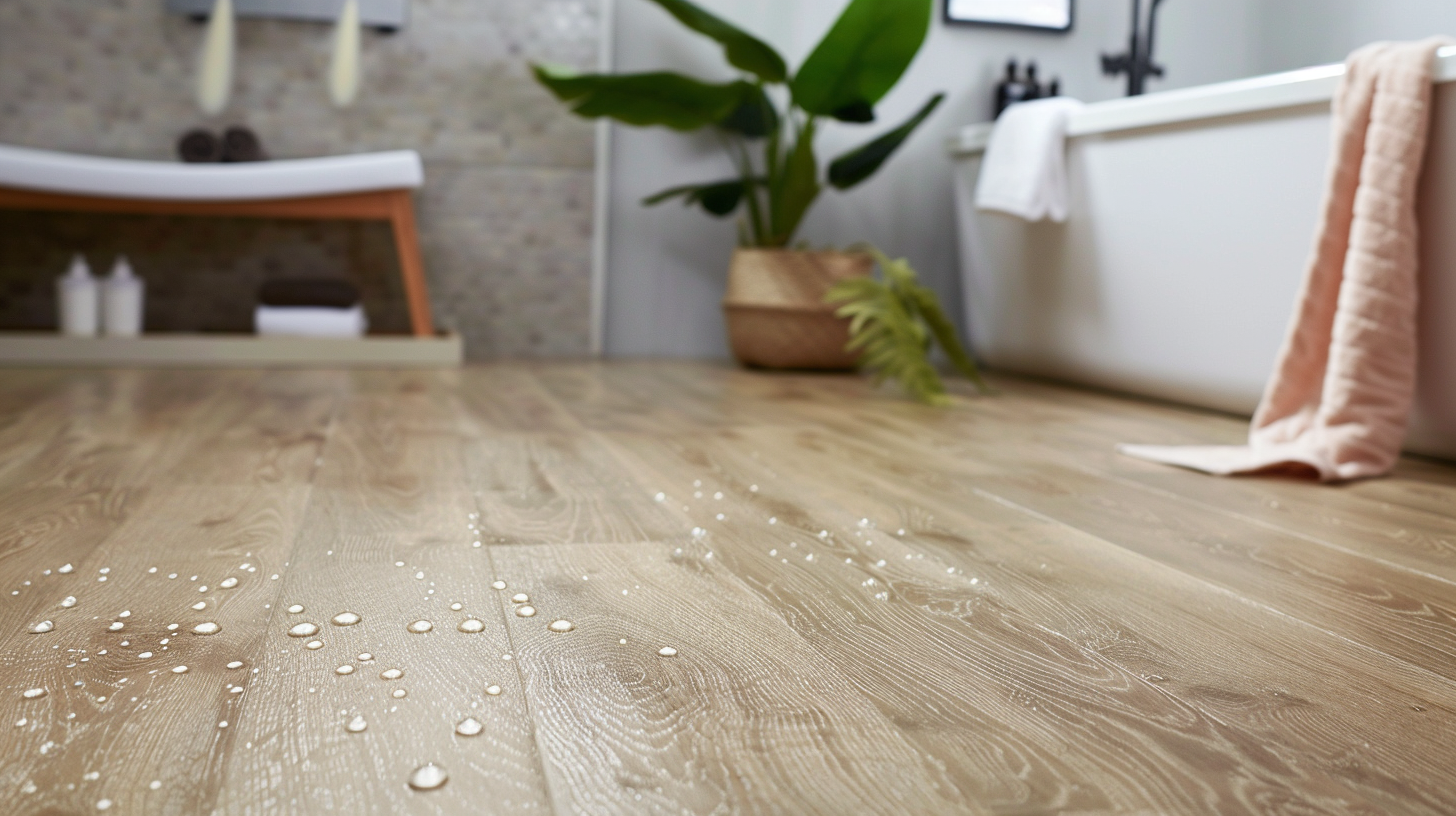
Have you ever wondered what occurs when water sneaks beneath your waterproof vinyl flooring? Let’s uncover the truth and protect your investment.
When water gets under waterproof vinyl flooring, it can lead to hidden damage despite its protective layers. Understanding the consequences and knowing how to respond can save you from costly repairs and maintain your floor’s integrity.
Imagine discovering water damage after noticing only minor issues on the surface. Let’s explore what happens and how to handle such situations effectively.
What to do if water gets under waterproof vinyl flooring?
What steps should you take if water seeps beneath your waterproof vinyl flooring?
If water gets under waterproof vinyl flooring, act quickly to minimize damage. Promptly addressing the issue can prevent warping, mold growth, and structural problems.
Dive Deeper into Addressing Water Under Vinyl Flooring
Handling water beneath vinyl flooring involves several key actions to ensure effective remediation and prevent long-term damage.
Immediate Actions
- Identify the Source: Locate where the water is coming from to stop further leakage.
- Remove Standing Water: Use mops, towels, or a wet/dry vacuum to eliminate excess water.
- Lift Affected Planks: Carefully remove any damaged vinyl planks to allow air circulation and drying.
Drying the Area
- Use Fans and Dehumidifiers: Enhance airflow and reduce humidity to speed up the drying process.
- Check Subfloor Condition: Inspect the subfloor for signs of moisture or damage and address any issues promptly.
Preventing Future Issues
- Seal Gaps and Edges: Ensure all seams and edges are properly sealed to prevent future water intrusion.
- Regular Maintenance: Periodically inspect your flooring for signs of wear or damage and address them immediately.
| Etapa | Ação | Objetivo |
|---|---|---|
| Identify the Source | Locate and stop the water leakage | Prevent further water intrusion |
| Remove Standing Water | Use mops, towels, or vacuum to eliminate water | Reduce moisture levels quickly |
| Lift Affected Planks | Remove damaged planks | Allow for thorough drying and inspection |
| Use Fans and Dehumidifiers | Enhance airflow and reduce humidity | Accelerate the drying process |
| Check Subfloor Condition | Inspect for moisture or damage | Address underlying issues |
| Seal Gaps and Edges | Properly seal all seams and edges | Prevent future water intrusion |
| Manutenção regular | Inspect and maintain flooring regularly | Ensure ongoing protection and durability |
By following these steps, you can effectively manage water issues and maintain the longevity of your vinyl flooring.
How long does it take for water to damage a vinyl floor?
How quickly can water cause damage to your vinyl flooring?
Water can start damaging vinyl flooring within hours, especially if it remains unaddressed. Prompt action is essential to prevent serious structural and aesthetic damage.
Dive Deeper into the Timeline of Water Damage
Understanding the timeline of water damage helps you respond appropriately and mitigate potential issues effectively.
Initial Exposure
- Immediate Effects: Within minutes, water begins to seep into seams and underlayment, starting the moisture intrusion process.
- Short-Term Impact: After a few hours, prolonged exposure can cause vinyl planks to warp, buckle, or delaminate from the subfloor.
Mid-Term Effects
- 24-48 Hours: If water remains, it can penetrate deeper into the subfloor, leading to mold growth and weakening of the structural integrity.
- Visible Signs: Discoloration, bubbling, or peeling of the vinyl surface may become noticeable within this period.
Long-Term Consequences
- Beyond 48 Hours: Persistent moisture can result in severe mold infestations, rot, and the need for extensive flooring repairs or replacements.
- Health Risks: Mold growth poses health risks, including respiratory issues and allergic reactions.
| Período de tempo | Effects | Actions Needed |
|---|---|---|
| Minutes | Water begins to seep into seams and underlayment | Immediate removal of water |
| Horas | Vinyl planks start to warp or delaminate | Lift planks and begin drying process |
| 24-48 Hours | Deeper subfloor penetration, mold risk | Use fans and dehumidifiers, inspect subfloor |
| Beyond 48 Hours | Severe mold, rot, extensive damage | Replace damaged flooring and subfloor |
| Health Risks | Respiratory issues from mold | Ensure complete drying and mold remediation |
By recognizing how quickly water can damage vinyl flooring, you can take swift action to protect your investment.
Is waterproof vinyl flooring really waterproof?
Can you trust that waterproof vinyl flooring will stay dry?
While waterproof vinyl flooring is highly water-resistant, it’s not entirely impervious to water. Proper installation and maintenance are crucial to ensure its effectiveness.
Dive Deeper into the Waterproofing of Vinyl Flooring
Exploring the true waterproof nature of vinyl flooring helps set realistic expectations and informs proper care practices.
Composition and Design
- Core Structure: Waterproof vinyl flooring typically has a rigid core made from materials like WPC1 (Wood Plastic Composite) or SPC2 (Stone Plastic Composite), which resist moisture.
- Camada de desgaste: A thick wear layer protects against spills and stains, preventing water from penetrating deeper layers.
Factores de instalação
- Seam Sealing: Properly sealed seams and edges are essential to prevent water from seeping underneath the flooring.
- Preparação do subpavimento: A flat and moisture-resistant subfloor ensures that water doesn’t find paths beneath the vinyl planks.
Limitações
- Extreme Conditions: Prolonged exposure to standing water or submersion can overwhelm the waterproof features, leading to damage.
- Installation Errors: Gaps, improper sealing, or subfloor moisture can compromise the flooring’s waterproof capabilities.
| Aspeto | Detalhes | Importância |
|---|---|---|
| Estrutura central | WPC or SPC for moisture resistance | Prevents water from penetrating core |
| Camada de desgaste | Thick protective layer | Shields against spills and stains |
| Seam Sealing | Properly sealed seams and edges | Blocks water from seeping underneath |
| Preparação da sub-base | Flat, moisture-resistant subfloor | Ensures no water paths beneath flooring |
| Condições extremas | Prolonged exposure can cause damage | Understanding limits of waterproofing |
| Erros de instalação | Gaps and improper sealing compromise waterproofing | Ensures effective water resistance |
Understanding these factors helps you maximize the waterproof benefits of your vinyl flooring.
Can mold grow under vinyl plank flooring?
Is there a risk of mold developing beneath your vinyl plank flooring?
Yes, mold can grow under vinyl plank flooring if moisture is present and not properly managed. Preventing mold requires controlling moisture and ensuring proper installation.
Dive Deeper into Mold Growth Under Vinyl Plank Flooring
Exploring the conditions that lead to mold growth and preventive measures helps maintain a healthy and safe environment.
Causes of Mold Growth
- Moisture Intrusion: Leaks, spills, or high humidity can introduce moisture beneath the flooring.
- Poor Ventilation: Inadequate airflow traps moisture, creating ideal conditions for mold to thrive.
- Organic Material Presence: The subfloor or underlayment may contain organic materials that serve as food for mold.
Estratégias de prevenção
- Proper Installation: Ensure tight seams, use moisture barriers, and maintain a flat subfloor to prevent water intrusion.
- Regular Maintenance: Quickly address spills and leaks, and maintain appropriate indoor humidity levels.
- Ventilation: Use fans, dehumidifiers, and ensure adequate airflow to keep the area dry.
Signs of Mold Under Flooring
- Musty Odors: A persistent musty smell can indicate hidden mold growth.
- Discoloration: Stains or discoloration on the flooring surface may signal moisture issues.
- Health Symptoms: Respiratory issues or allergic reactions among occupants can be a sign of mold presence.
| Fator | Impact on Mold Growth | Prevention Measures |
|---|---|---|
| Intrusão de humidade | Introduces water needed for mold | Seal seams, use moisture barriers |
| Ventilação deficiente | Traps moisture, creates humid conditions | Ensure adequate airflow and use dehumidifiers |
| Organic Material Presence | Provides food for mold | Use non-organic underlayments, keep subfloor clean |
| Instalação correta | Prevents water and mold entry | Hire professionals, follow manufacturer guidelines |
| Manutenção regular | Reduces moisture and mold risk | Address spills immediately, maintain humidity levels |
| Ventilation | Keeps area dry and mold-free | Use fans, open windows, install exhaust systems |
| Signs of Mold | Early detection can prevent spread | Regular inspections, address odors and stains promptly |
By implementing these strategies, you can significantly reduce the risk of mold growth under your vinyl plank flooring.
Conclusão
Water beneath vinyl flooring can cause hidden damage and mold. Act swiftly to protect your floors and maintain a healthy space.
Notas de rodapé:
-
Learn the potential consequences of standing water on vinyl flooring, including how it can compromise its waterproof features and lead to damage. ↩
-
Discover the differences between WPC and SPC vinyl flooring to make informed decisions on which material is right for your needs based on water resistance and durability. ↩


